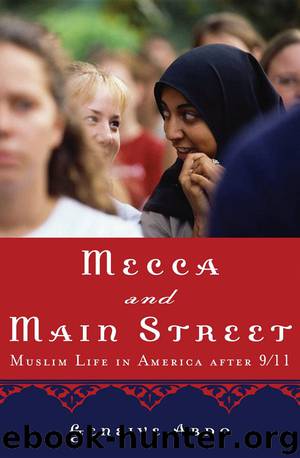Mecca and Main Street : Muslim Life in America after 911 by Geneive Abdo

Author:Geneive Abdo
Language: eng
Format: epub
Publisher: Oxford University Press, USA
The South Side was ripe territory for bridging the divide among African Americans, Latinos, and Arabs under the banner of Islam. Even those who knew next to nothing about the religion perceived Islam as a faith for the disenfranchised, such as the African Americans and Latinos living in South Chicago. And the Arabs, some of whom were recent immigrants, were attuned to the Islamic revival, either having witnessed it firsthand in their native countries or having heard about it from their relatives. This made them more receptive to the Islamic call.
The African Americans in South Chicago were also drawn to IMAN’s Islamic message because they had grown up with at least a vague idea of the faith. Chicago had long been a hotbed of spirituality and religious foment. More than one hundred years ago, it hosted the World’s Parliament of Religions, which first introduced Islam to many Americans, and it was once home to an early Muslim missionary movement from India. The Nation of Islam was headquartered in the city.
Some African Americans of Rami’s generation who were seeking to convert tried to join the Nation, but they were discouraged by its radical ideas. And immigrant Muslims felt they were not welcomed because of their race. By the 1990s, the Nation and its leader Louis Farrakhan had mellowed; there was no more talk about whites being the Devil. But the movement was still more focused on African American rights and the plight of the ghetto than on religion.
African American youth growing up in the 1980s had at least heard about the Nation and Warith Deen’s breakaway movement. Their greatest hero, though, was Malcolm X. Malcolm X’s legacy differed greatly from his image during his lifetime. For the younger generation, Malcolm was a hybrid of Farrakhan and Warith Deen Muhammad—someone who sought to practice Islam within the tradition of orthodox Sunni Islam but who also championed African American rights.
Among the Arabs of South Chicago, the community gradually shifted from one that was decidedly Arabic to one that had a more general Islamic identity. Changes in the types of immigrants who came to the area contributed to this transition. Toward the end of the nineteenth century, Turkish, Syrian, and Lebanese immigrants began settling in Chicago. According to the 1910 census, there were 772 people of Arab descent living in Chicago. Immigration laws enacted in the early 1920s barred Muslims from entering the country, separating those who had settled a bit earlier from their families.
Download
This site does not store any files on its server. We only index and link to content provided by other sites. Please contact the content providers to delete copyright contents if any and email us, we'll remove relevant links or contents immediately.
The Lost Art of Listening by Michael P. Nichols(7170)
Why I Am Not A Calvinist by Dr. Peter S. Ruckman(4051)
The Rosicrucians by Christopher McIntosh(3375)
Wicca: a guide for the solitary practitioner by Scott Cunningham(3046)
Signature in the Cell: DNA and the Evidence for Intelligent Design by Stephen C. Meyer(2880)
Real Sex by Lauren F. Winner(2873)
The Holy Spirit by Billy Graham(2782)
To Light a Sacred Flame by Silver RavenWolf(2681)
The End of Faith by Sam Harris(2637)
The Gnostic Gospels by Pagels Elaine(2403)
Waking Up by Sam Harris(2334)
Nine Parts of Desire by Geraldine Brooks(2283)
Jesus by Paul Johnson(2232)
Devil, The by Almond Philip C(2207)
The God delusion by Richard Dawkins(2193)
Heavens on Earth by Michael Shermer(2191)
Kundalini by Gopi Krishna(2094)
Chosen by God by R. C. Sproul(2058)
The Nature of Consciousness by Rupert Spira(1983)
